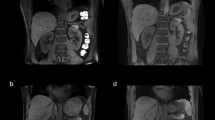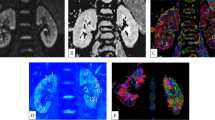Abstract
Purpose
Few studies of renal iron content have been performed with multiecho gradient-echo (ME–GRE) T2* magnetic resonance imaging (MRI). We assessed the feasibility and reproducibility of ME–GRE T2* MRI for measuring regional and global renal T2* values, and established the lower limits of normal in healthy subjects, also correlating the measured values with age and sex.
Methods
Twenty consecutive healthy subjects (13 men and 7 women, mean age 29.1 ± 7.2 years, range 19–42 years) underwent MRI examinations using a 1.5 T magnet and an ME–GRE T2* sequence. For each kidney, T2* was measured in anterior, posterolateral, and posteromedial renal parenchymal regions. The mean T2* value was calculated as the average of the two kidneys T2* values.
Results
For the mean kidney T2* value, the coefficients of variation for intra- and inter-operator reproducibility were 1.76% and 6.23%, respectively. The lower limit of normal for the mean kidney T2* value was 31 ms (median 51.39 ± 10.09). There was no significant difference between left and right kidney T2* values (p = 0.578). No significant correlation was found between T2* values and subjects’ age or sex.
Conclusions
Renal ME-GRE T2* appears to be a feasible and reproducible technique. The renal T2* values showed no dependence on sex or age.



Similar content being viewed by others
References
Anderson GJ (2007) Mechanisms of iron loading and toxicity. Am J Hematol 82:1128–1131
Maggio A, Capra M, Pepe A, et al. (2008) A critical review of non invasive procedures for the evaluation of body iron burden in thalassemia major patients. Pediatr Endocrinol Rev 6(Suppl 1):193–203
Hentze MW, Muckenthaler MU, Andrews NC (2004) Balancing acts: molecular control of mammalian iron metabolism. Cell 117:285–297
Price L, Kowdley KV (2009) The role of iron in the pathophysiology and treatment of chronic hepatitis C. Can J Gastroenterol 23:822–828
Papakonstantinou O, Alexopoulou E, Economopoulos N, et al. (2009) Assessment of iron distribution between liver, spleen, pancreas, bone marrow, and myocardium by means of R2 relaxometry with MRI in patients with beta-thalassemia major. J Magn Reson Imaging 29:853–859
Noetzli LJ, Papudesi J, Coates TD, Wood JC (2009) Pancreatic iron loading predicts cardiac iron loading in thalassemia major. Blood 114:4021–4026
Relia N, Kaushik C (2010) Renal hemosiderosis: a case of black kidneys causing renal failure. J Postgrad Med 56:216–217
Bhandari S, Galanello R (2012) Renal aspects of thalassaemia a changing paradigm. Eur J Haematol 89:187–197
Mastrangelo F, Lopez T, Rizzelli S, et al. (1975) Function of the kidney in adult patients with Cooley’s disease. A preliminary report. Nephron 14:229–236
Landing BH, Gonick HC, Nadorra RL, et al. (1989) Renal lesions and clinical findings in thalassemia major and other chronic anemias with hemosiderosis. Pediatr Pathol 9:479–500
Bhandari S, Daar S (2012) Deferasirox and renal dysfunction in children. Pediatr Nephrol 27:2159
Brittenham GM, Badman DG, National Instituteof Diabetes and Digestive and Kidney Diseases (NIDDK) Workshop (2003) Noninvasive measurement of iron: report of an NIDDK workshop. Blood 101:15–19
Anderson LJ, Holden S, Davis B, et al. (2001) Cardiovascular T2-Star (T2*) magnetic resonance for the early diagnosis of myocardial iron overload. Eur Heart J 22:2171–2179
Carpenter J-P, He T, Kirk P, et al. (2011) On T2* magnetic resonance and cardiac iron. Circulation 123:1519–1528
Ramazzotti A, Pepe A, Positano V, et al. (2009) Multicenter validation of the magnetic resonance T2* technique for segmental and global quantification of myocardial iron. J Magn Reson Imaging 30:62–68
Au W-Y, Lam WW-M, Chu W, et al. (2008) A T2* magnetic resonance imaging study of pancreatic iron overload in thalassemia major. Haematologica 93:116–119
Restaino G, Meloni A, Positano V, et al. (2011) Regional and global pancreatic T2* MRI for iron overload assessment in a large cohort of healthy subjects: normal values and correlation with age and gender. Magn Reson Med 65:764–769
Schein A, Enriquez C, Coates TD, Wood JC (2008) Magnetic resonance detection of kidney iron deposition in sickle cell disease: a marker of chronic hemolysis. J Magn Reson Imaging 28:698–704
Hashemieh M, Azarkeivan A, Akhlaghpoor S, et al. (2012) T2-star (T2*) magnetic resonance imaging for assessment of kidney iron overload in thalassemic patients. Arch Iran Med 15:91–94
Levey AS, Stevens LA, Schmid CH, et al. (2009) A new equation to estimate glomerular filtration rate. Ann Intern Med 150:604–612
Positano V, Salani B, Pepe A, et al. (2009) Improved T2* assessment in liver iron overload by magnetic resonance imaging. Magn Reson Imaging 27:188–197
Wood JC (2007) Magnetic resonance imaging measurement of iron overload. Curr Opin Hematol 14:183–190
Rossi C, Boss A, Haap M, et al. (2009) Whole-body T2* mapping at 1.5 T. Magn Reson Imaging 27:489–496
Prasad PV, Edelman RR, Epstein FH (1996) Noninvasive evaluation of intrarenal oxygenation with BOLD MRI. Circulation 94:3271–3275
Simon-Zoula SC, Hofmann L, Giger A, et al. (2006) Non-invasive monitoring of renal oxygenation using BOLD-MRI: a reproducibility study. NMR Biomed 19:84–89
Acknowledgments
We thank all the healthy subjects for their cooperation. We also thank Claudia Santarlasci for her skillful secretarial work.
Author information
Authors and Affiliations
Corresponding author
Additional information
Emanuele Grassedonio and Antonella Meloni have contributed equally to this article.
Rights and permissions
About this article
Cite this article
Grassedonio, E., Meloni, A., Positano, V. et al. Quantitative T2* magnetic resonance imaging for renal iron overload assessment: normal values by age and sex. Abdom Imaging 40, 1700–1704 (2015). https://doi.org/10.1007/s00261-015-0395-y
Published:
Issue Date:
DOI: https://doi.org/10.1007/s00261-015-0395-y




